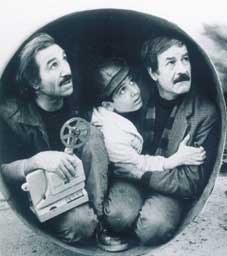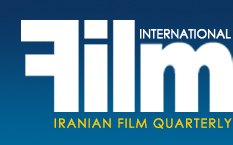|
Genre in the Iranian Cinema
Genre, Iranian Style
by Mehrzad Danesh
|
 The genre discourse in the cinema has its roots in the way structural and thematic patterns of films were classified in the American studio system in the mid-20th century decades, but it was gradually transmitted to the films produced in other countries as well, including Iran. In the years prior to the 1979 revolution in Iran, however, there wasn’t much discussed in this regards due to the general similarity of all films produced in Iran. An amalgam of comedy, action, melodrama, musical and everything else was being used in most films, with no credit to be given to any single genre. But these classifications slowly started to be used for the films produced and presented after the Revolution. Some of the genres could not be used in the context of the Iranian cinema, such as the Western, which is basically an American genre, and therefore had no place in the Iranian cinema. There was only a single slapstick comedy made in this genre in the pre-revolutionary era, and a satire in the years after. Of course there are inspirations from this genre in some films such as Duel (2003, Ahmad Reza Darvish), and Karat 14 (2008, Parviz Shahbazi) and a few more films. The same goes with Noir. Since the vamp/seductress is such a major component of this genre, which could not be presented in the Iranian current movies due to religious restrictive rules, Iranian filmmakers could not produce a good Noir film, one of the failed examples of which could be The Extortionist (2003, Farzad Motamen). However, very few successful neo-Noir films, such as The Hemlock (1998, Behrooz Afkhami) and Retribution (2010, Hasan Fahti) could be traced here and there. There are many reasons why science fiction films could not be made in Iran: lack of a literary tradition of this genre in the Iranian literature, and a lack of developed technical facilities to create those fantastic and mind-boggling scenes, and also the ruling ideology which sanctions looking into the future and the use of fantasy which are inherent necessities of the genre. The genre discourse in the cinema has its roots in the way structural and thematic patterns of films were classified in the American studio system in the mid-20th century decades, but it was gradually transmitted to the films produced in other countries as well, including Iran. In the years prior to the 1979 revolution in Iran, however, there wasn’t much discussed in this regards due to the general similarity of all films produced in Iran. An amalgam of comedy, action, melodrama, musical and everything else was being used in most films, with no credit to be given to any single genre. But these classifications slowly started to be used for the films produced and presented after the Revolution. Some of the genres could not be used in the context of the Iranian cinema, such as the Western, which is basically an American genre, and therefore had no place in the Iranian cinema. There was only a single slapstick comedy made in this genre in the pre-revolutionary era, and a satire in the years after. Of course there are inspirations from this genre in some films such as Duel (2003, Ahmad Reza Darvish), and Karat 14 (2008, Parviz Shahbazi) and a few more films. The same goes with Noir. Since the vamp/seductress is such a major component of this genre, which could not be presented in the Iranian current movies due to religious restrictive rules, Iranian filmmakers could not produce a good Noir film, one of the failed examples of which could be The Extortionist (2003, Farzad Motamen). However, very few successful neo-Noir films, such as The Hemlock (1998, Behrooz Afkhami) and Retribution (2010, Hasan Fahti) could be traced here and there. There are many reasons why science fiction films could not be made in Iran: lack of a literary tradition of this genre in the Iranian literature, and a lack of developed technical facilities to create those fantastic and mind-boggling scenes, and also the ruling ideology which sanctions looking into the future and the use of fantasy which are inherent necessities of the genre.
What follows is a brief study of eight distinct genres in the Iranian cinema: Comedy, Melodrama, Historical, Sports movies, Political/Social, War films, Musicals, Horror, and Religious. It should be noted, however, that some of these titles are not real genres (such as religious and social, which could be described as the tone of the movies) but are used in this study due to their strong presence in the Iranian cinema...
...SUBSCRIBE
[Page: 44]
|
|
|
|
|
President & Publisher
Massoud Mehrabi
Editors:
Sohrab Soori
Translators:
Sohrab Soori
Vazrik Der-Sahakian
Behrouz Tourani
Zohreh Khatibi
Contributors
Mehrzad Danesh
Advertisements
Mohammad Mohammadian
Art Director
Babak Kassiri
Ad Designers
Amir Kheirandish
Hossein Kheirandish
Cover Design
Alireza Amakchi
Correspondents
E.Emrani & M. Behraznia (Germany)
Mohammad Haghighat (France)
A. Movahed & M. Amini (Italy)
Robert Richter (Switzerland)
F. Shafaghi (Canada)
B. Pakzad (UAE)
H. Rasti (Japan)
Print Supervisors
Shad-Rang
Noghreh-Abi
Gol-Naghsh
Subscription & Advertising Sales
Address: 10, Sam St., Hafez Ave., TEHRAN, IRAN
Phone: +98 21 66722444
Fax: +98 21 66718871
info@film-magazine.com
Copyright: Film International
© All rights reserved,
2023, Film International
Quarterly Magazine (ISSN 1021-6510)
Editorial Office: 5th Floor, No. 10
Sam St., Hafez Ave., Tehran 11389, Iran
Printed in Tehran
Publishing Date Summer 2011
*
All articles represent views of their
authors and not necessarily
those of the editors
|
|
|

